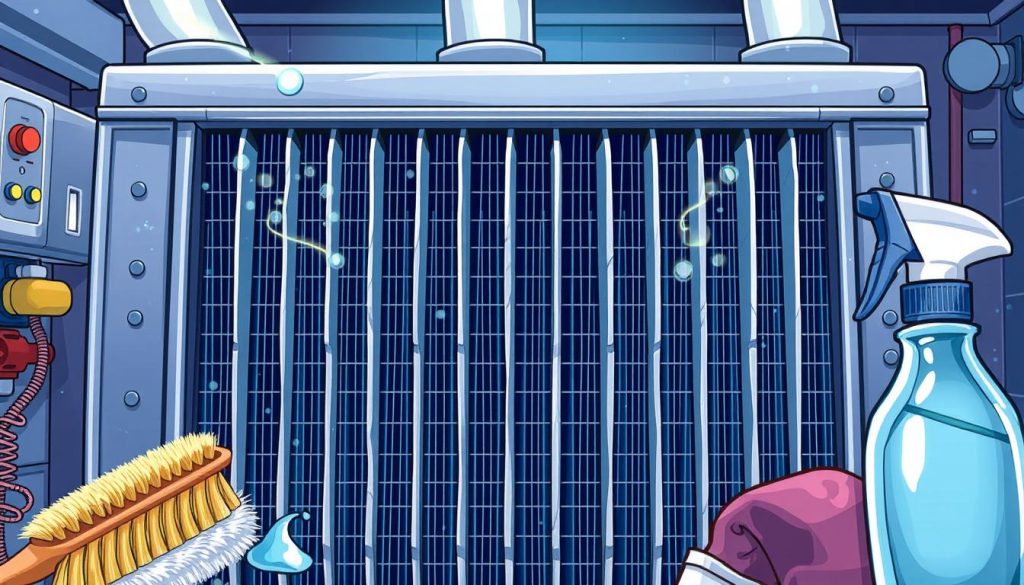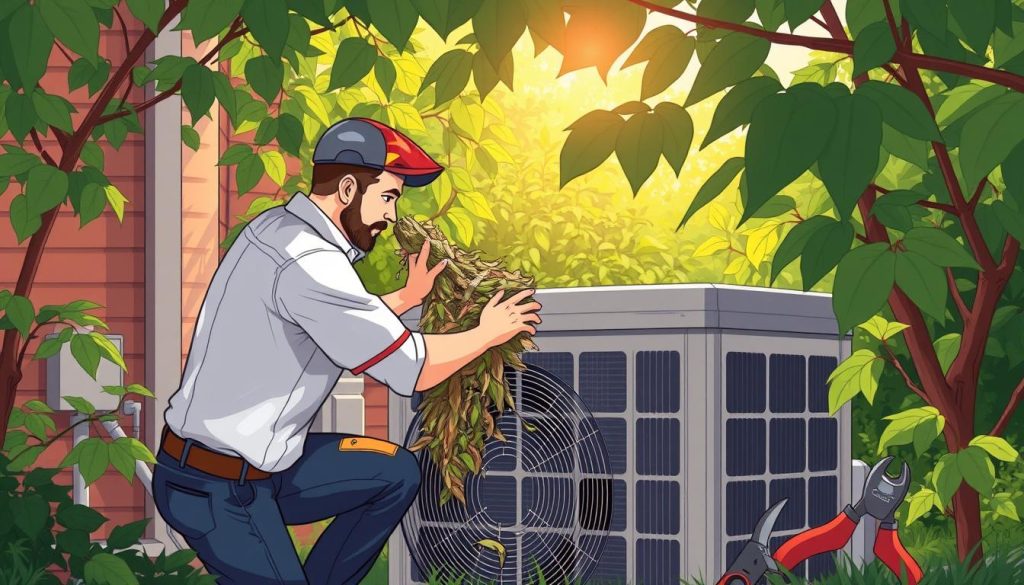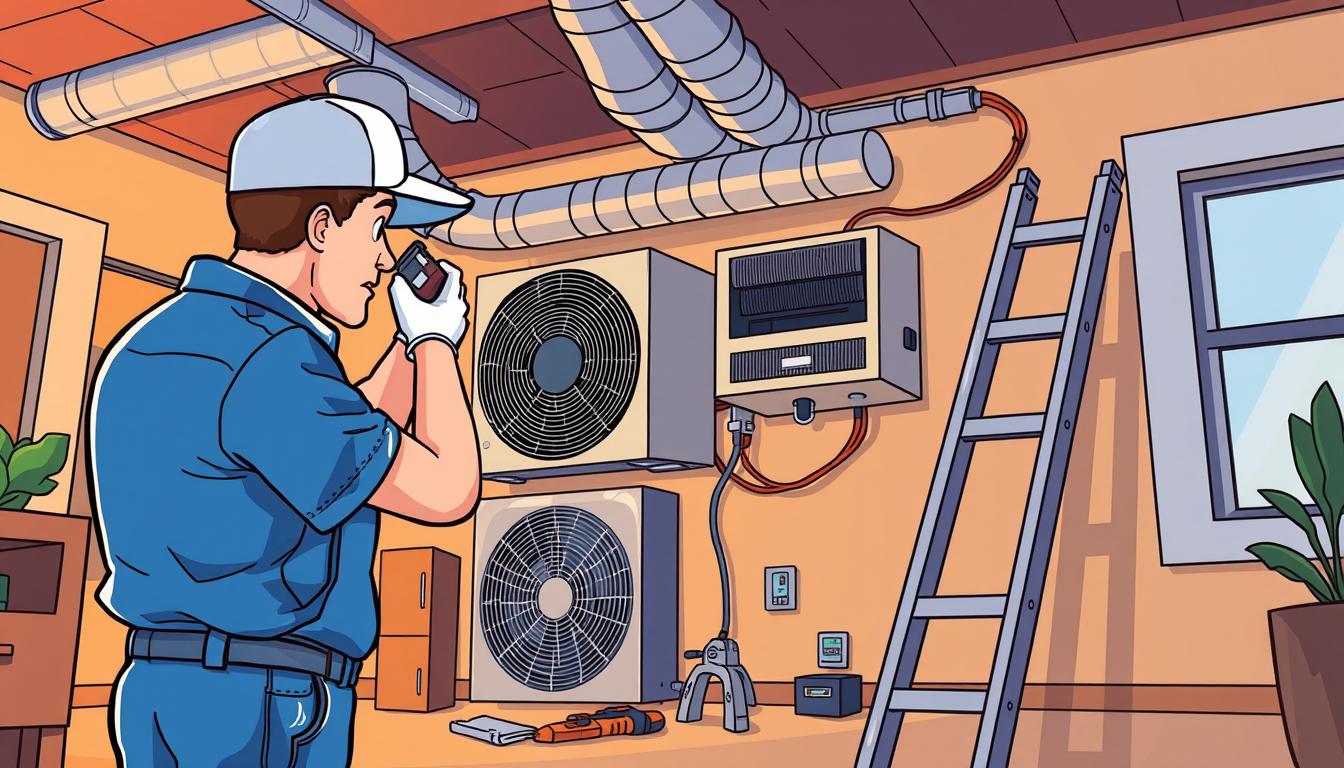Keeping your HVAC system in top shape is key for good performance, energy use, and air quality. Regular checks can spot problems early, saving you time, money, and stress. This guide will show you how to test your HVAC system to make sure it’s working well.
Key Takeaways
- Regularly inspect your thermostat to ensure it’s accurately reading the temperature and calibrate or replace it if necessary.
- Perform a cooling test to ensure your HVAC system is properly cooling your home and listen for any unusual noises during operation.
- Check and replace your air filters to maintain optimal airflow and indoor air quality.
- Inspect your ductwork to identify any supply and return air temperature differences, which could indicate a leak or other issue.
- Clean your evaporator coils and level the outdoor unit to maintain efficient operation.
Inspect the Thermostat
To test your HVAC system, start by checking the thermostat. This key part helps control your home’s temperature. Look closely at the thermostat to find any problems that might be affecting your system’s performance.
Compare Thermostat Reading to External Thermometer
First, compare the thermostat’s temperature reading to an external thermometer. This thermometer should not be connected to your HVAC system. If the readings are off by even a degree, your thermostat might not be working right. This could mean it needs calibration or replacement.
Calibrate or Replace Thermostat if Necessary
- If the readings don’t match, you might be able to fix the thermostat. Check your user manual or contact the maker for help with calibration.
- If fixing it doesn’t work, or if the readings still don’t match, it’s time to replace the thermostat. A good thermostat is key for your HVAC system’s temperature accuracy and thermostat calibration.
By thermostat testing and fixing any problems, you can make sure your HVAC system works well. This ensures your home stays comfortable and at the right temperature.
Perform a Cooling Test
To make sure your HVAC system works well, you should do a cooling test. This easy test shows how your air conditioner is doing. It also finds any problems. Here’s how to do a complete HVAC cooling test:
Set Thermostat to Desired Temperature
First, set your thermostat to a comfy temperature. This should match what you want your air conditioning performance to be. Let the system run for a bit to get stable.
Listen for Unusual Noises During Operation
While the air conditioner is on, listen for odd sounds. Look out for rattles, squeaks, or slapping. These sounds might mean you need to HVAC troubleshooting help. Finding these issues early helps avoid bigger problems.
Doing a full HVAC cooling test is key to keeping your air conditioner running right. Watch the temperature and listen for strange noises. This way, you can fix problems fast and keep your home cool and comfy all year.
Check and Replace Air Filters
Keeping your HVAC system’s air filters clean is key for air quality and efficiency. A dirty filter can cause many issues. So, it’s important to keep up with regular maintenance.
When Should I Replace My HVAC Air Filter?
Change your HVAC air filter every 1-3 months. Do it more often if your system runs a lot or if you have pets, carpets, or live in a dusty area. Not changing it can lead to poor airflow, higher energy use, and more pollutants and allergens in your home.
How Do I Check My HVAC Air Filter?
- Find the air filter access panel, usually near the blower unit or at the return air vent.
- Look at the filter – if it’s full of dust and debris, it’s time for a new one.
- Hold the filter up to a light; if light can’t pass through, it’s too dirty and needs to be replaced.
Choosing the Right HVAC Air Filter
When picking a new air filter, make sure it fits your system and has the right MERV rating. Higher MERV ratings catch smaller particles, but might reduce airflow. Check your HVAC manual or ask a pro to find the best filter for you.
| MERV Rating | Particle Size Range | Filtration Efficiency |
|---|---|---|
| 1-4 | 10-100 microns | 10-20% |
| 5-8 | 3-10 microns | 20-35% |
| 9-12 | 1-3 microns | 40-75% |
| 13-16 | 0.3-1 microns | 75-95% |
Regular HVAC air filter care is vital for your system’s health and air quality. By checking and replacing filters as needed, you’ll keep your HVAC running well and your home comfortable and healthy.
Inspect Ductwork
Keeping your HVAC system in top shape is more than just checking the thermostat and air filters. It’s also important to regularly inspect your ductwork. This helps ensure your air circulates well and spots any problems early on. By knowing the difference between supply and return ducts and checking temperature differences, you can find and fix HVAC duct issues quickly.
Identify Supply and Return Ducts
To start inspecting your ductwork, figure out which ducts send air into your home and which take it back. Just put a tissue paper over the registers. If it gets pulled in, it’s a return duct. If it gets blown out, it’s a supply duct.
Measure Temperature Difference
After finding out which ducts are supply and return, measure the temperature difference. Turn on your air conditioning and set the thermostat lower than the room temperature. Wait about 10 minutes, then use a thermometer to check the temperature in the closest supply and return ducts. If the difference is less than 20 degrees Fahrenheit, it might mean there’s a problem with your HVAC duct inspection, duct leakage testing, or air flow testing.
By regularly checking your HVAC ductwork and measuring temperature differences, you can keep your system running smoothly. This way, you can catch any issues before they get worse.
How do I test my HVAC system?
Keeping your HVAC system in top shape is key for comfort and saving energy at home. Testing it regularly can spot problems early. Here’s how to do it:
Inspect the Thermostat
First, check your thermostat to make sure it’s showing the right temperature. Compare it to an outside thermometer. If they don’t match, you might need to adjust or replace the thermostat.
Perform a Cooling Test
Set your thermostat to cool and listen for odd sounds. Make sure the air from the vents is cool and the fan works right.
Check and Replace Air Filters
Dirty air filters can slow down your HVAC system. Always check and change them as the maker suggests.
Inspect the Ductwork
Look for damage or leaks in your ducts. Find the supply and return ducts and check the temperature difference. This ensures air is being distributed well.
Clean the Evaporator Coils
The evaporator coils are key for cooling. Open the coil door and use a no-rinse cleaner to keep them efficient.
Level the Outdoor Unit
Make sure the outdoor unit is level and stable. An uneven base can hurt the system’s performance.
Clear Debris from the Outdoor Unit
Take off the fan cage and vacuum around the outdoor unit. Straighten any bent fins to keep air flowing well.
By following these steps, you can test your HVAC system well and find any problems. Regular checks and upkeep can make your system last longer, save energy, and keep your home comfy all year.
Clean Evaporator Coils
The evaporator coils in your HVAC system are key to keeping the air inside your home clean. They can get wet and grow microbes, leading to bad smells and poor air quality. This is because they work in damp conditions.
Open the Evaporator Coil Door
To clean the evaporator coils, first find and open the access panel or door. This is usually inside the indoor unit of your HVAC system. Check your manufacturer’s guide for how to get to the coils.
Apply a No-Rinse Coil Cleaner
After you open the coil, use a no-rinse coil cleaner for HVAC evaporator coil cleaning. These cleaners get rid of microbial growth and dirt without rinsing. Make sure to follow the instructions for the best results.
Cleaning the evaporator coils regularly is crucial for good indoor air quality. It stops harmful microorganisms from growing. By doing this, your HVAC system works better and keeps your home’s air fresh.

Level the Outdoor Unit
Keeping your outdoor unit in top shape is key for its efficiency and performance. One critical step is to make sure it’s level. The ground can shift, making the unit tilt. A tilted unit can hurt its air conditioner’s performance and shorten its life.
To see if your unit is level, just look at it. Check for any tilt or unevenness. You can also use a level tool to confirm. If it’s not level, you’ll need to fix it.
- Find rot-resistant shims, which are small wedge-shaped pieces, usually made of plastic or treated wood.
- Put the shims under the low side of the outdoor unit until it’s level.
- Make sure the unit is stable and won’t rock or shift.
Leveling your HVAC outdoor unit is a simple task that greatly benefits your air conditioning system. By checking and leveling the unit, you help it work better for longer. This keeps your HVAC system running smoothly for years.
Clear Debris from Outdoor Unit
Keeping your HVAC system’s outdoor unit clean is key for its good working and long life. It’s important to remove any debris that has built up around or inside the unit. This includes taking off the fan cage and vacuuming out leaves, twigs, and other particles that can block airflow and harm the unit’s parts.
Remove Fan Cage and Vacuum Debris
First, find the protective fan cage on the outdoor unit. Carefully remove it, watching out for any electrical connections. Then, use a wet/dry vacuum to clean out the unit’s interior, getting rid of leaves, dirt, or other debris. Make sure to clean every corner to get it all done.
Straighten Bent Fins
After cleaning out the debris, check the condenser coil fins. These thin metal fins can bend or get damaged, which can hurt the HVAC system’s HVAC outdoor unit maintenance and lower its efficiency. Use a butter knife or a fin-straightening tool to gently fix any bent fins, being careful not to make them worse. This small step can greatly improve the unit’s condenser cleaning and fin straightening performance.
By regularly keeping the outdoor HVAC unit clean and removing debris, you can help your system work better. This can lower your energy bills and make your system last longer. Always be careful when working on the outdoor unit. If you’re unsure or have concerns, it’s best to get help from a professional HVAC technician.

Check for Unusual Odors
Keeping your indoor air quality high is important. Unusual odors from your HVAC system can be a sign of a problem. Microbiological growth, like mold or mildew, can cause bad smells.
Notice any odd smells from your HVAC? It’s time to act fast. These smells might mean there’s a bigger issue with HVAC indoor air quality or microbial growth detection in your system.
Potential Causes of Unusual HVAC Odors
- Buildup of microbial growth on the evaporator coils
- Trapped moisture or stagnant water within the HVAC system
- Deterioration of internal components, such as insulation or ductwork
- Presence of dead animals or pests within the HVAC system
If you think the smell is from your HVAC, get a pro to check it out. A HVAC troubleshooting expert can clean the coils, fix moisture issues, and make sure your system works well without odors.
| Odor Type | Possible Cause | Recommended Action |
|---|---|---|
| Musty or moldy smell | Microbial growth on evaporator coils | Schedule a professional HVAC coil cleaning |
| Rotten egg or sulfur-like smell | Potential gas leak or electrical issue | Shut off power and contact a professional immediately |
| Burning or acrid smell | Overheating components or electrical issues | Shut off power and contact a professional immediately |
Fixing unusual odors quickly and with a pro’s help keeps your HVAC indoor air quality good. This makes your home or building a healthier, more comfortable place for everyone.
Conclusion
Keeping your HVAC system in good shape is key. It ensures your home stays comfy all year and saves you from expensive repairs. Regular checks and fixes help a lot.
This guide shows you how to test and fix your HVAC system yourself. You’ll learn to check the thermostat, clean the evaporator coils, and more. These steps help keep your system working well.
Being consistent is the secret to good HVAC maintenance. Regular checks and fixes help avoid problems. This way, your HVAC system will keep your home comfortable for a long time.





0 Comments